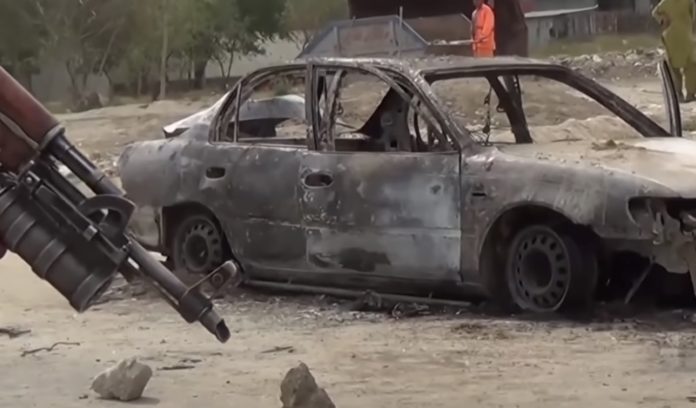OPINION | This article contains opinion. This site is licensed to publish this content.
An explosive report reveals the identity of a man killed by the U.S. military in a drone strike under the Biden administration’s orders.
The Biden administration claimed the target would neutralize an ISIS threat.
Instead, the man was actually an aid worker who worked for a U.S. organization. The man had applied for refugee resettlement in the U.S.
The driver has been identified as 43-year-old Zemari Ahmadi.
Ahmadi is a longtime worker for a U.S. aid group.
The U.S. military has conceded that the drone strike might have killed three civilians, but the investigate reports shows that 10 were killed, including seven children.
The drone strike occurred in a dense residential block.
The investigative report is the result of an exhaustive review of video footage from that day as well as interviews with individuals on the ground in Afghanistan. The Daily Wire’s report is corroborated by several other sources.
The report “raised serious doubts about the Biden administration’s version of events,” Daily Wire notes.
The Biden administration claimed there were explosives were present in the vehicle, the driver had a connection to ISIS, and that there was a second explosion after the missile struck the car.
An analysis of video feeds shows Mr. Ahmadi and a colleague loading canisters of water into his trunk to bring home to his family. The U.S. military presumably believed these were explosives.
Interviews with family members, co-workers and witnesses, reveals that Ahmadi’s travels that day involved transporting colleagues to and from work.
More from Daily Wire:
Ahmadi, 43, worked for Nutrition and Education International (NEI), a U.S.-based organization. The morning of the day that he was killed he left for work in his white Toyota Corolla, at which time the U.S. started surveilling a white sedan because it allegedly had left a location thought to be an ISIS safe house.
“It is unclear if officials were referring to one of the three stops that Mr. Ahmadi made to pick up two passengers and the laptop on his way to work: The latter location, the home of N.E.I.’s country director, was close to where a rocket attack claimed by ISIS would be launched against the airport the following morning, from an improvised launcher concealed inside the trunk of a Toyota Corolla, a model similar to Mr. Ahmadi’s vehicle,” the report said. “Throughout the day, an MQ-9 Reaper drone continued to track Mr. Ahmadi’s vehicle as it drove around Kabul, and U.S. officials claimed they intercepted communications between the sedan and the alleged ISIS safe house, instructing it to make several stops. But the people who rode with Mr. Ahmadi that day said that what the military interpreted as a series of suspicious moves was simply a normal day at work”…
— Advertisement —
“Although the target was now inside a densely populated residential area, the drone operator quickly scanned and saw only a single adult male greeting the vehicle, and therefore assessed with ‘reasonable certainty’ that no women, children or noncombatants would be killed, U.S. officials said,” the report said. “But according to his relatives, as Mr. Ahmadi pulled into his courtyard, several of his children and his brothers’ children came out, excited to see him, and sat in the car as he backed it inside.”
“Since the strike, U.S. military officials justified their actions by citing an even larger blast that took place afterward,” the report noted. “But an examination of the scene of the strike, conducted by the visual investigations team and a reporter the morning afterward, and followed up with a second visit four days later, found no evidence of a second, more powerful explosion. Experts who examined photos and videos pointed out that, although there was clear evidence of a missile strike and subsequent vehicle fire, there were no collapsed or blown-out walls, no destroyed vegetation, and only one dent in the entrance gate, indicating a single shock wave.”
Ahmadi was a 14-year employee of Nutrition & Education International, a U.S. NGO that fights malnutrition. He helped start up soy factories, repair machinery, transport his colleagues and distribute food from his Corolla to displaced Afghans. pic.twitter.com/S7r1TyHBs0
— Evan Hill (@evanhill) September 10, 2021
But @mattaikins interviewed all 5 men who were in the car with Ahmadi that day. They said that what the military interpreted as a series of suspicious moves represented a typical day in his life. He drove his colleagues around town, where they made plans for food distributions. pic.twitter.com/qD08rGmomI
— Evan Hill (@evanhill) September 10, 2021
The office security camera we obtained is crucial to understand what happens next. Though the camera settings are off, @mattaikins verified its time by visiting the office, and @ckoettl matched what we see on camera with timestamped satellite imagery. pic.twitter.com/luLCQXgkpn
— Evan Hill (@evanhill) September 10, 2021
At 3:38pm, a colleague drives Ahmadi’s car farther into the office driveway. At roughly the same time, the military said, the drone team saw Ahmadi’s car pull into an "unknown compound" 8 to 12 kilometers southwest of the airport. pic.twitter.com/BlYOmZ0yOc
— Evan Hill (@evanhill) September 10, 2021
Ahmadi drops his colleagues off and turns onto his street. His and his brothers’ children surround the car, his relatives said. The family has a habit of letting kids steer the car into the courtyard of their home. Somehow, the military said, the drone team sees none of this. pic.twitter.com/HjRbHxN5QX
— Evan Hill (@evanhill) September 10, 2021
We gathered photos and videos of the scene taken by journalists, and @mattaikins visited the courtyard multiple times. We shared that evidence with three experts. All three agreed that the damage was consistent with a single Hellfire strike, and not large secondary explosions. pic.twitter.com/HUXcZFHwCL
— Evan Hill (@evanhill) September 10, 2021






